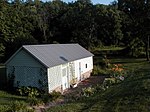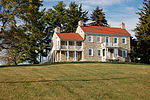Tomahawk, West Virginia
Eastern Panhandle geography stubsUnincorporated communities in Berkeley County, West VirginiaUnincorporated communities in West VirginiaUse mdy dates from July 2023

Tomahawk is an unincorporated community on Back Creek in Berkeley County, West Virginia, United States. The community is named for a nearby series of springs in the shape of a tomahawk. The community includes the historic Tomahawk Presbyterian Church, established c. 1745, and its adjacent community cemetery, which has gravestones dating to the late 18th century. Tomahawk also has a popular dirt bike racetrack. The community lies 9.5 miles from Martinsburg. Tomahawk Spring and the Park's Gap Bridge were listed on the National Register of Historic Places in 1994.
Excerpt from the Wikipedia article Tomahawk, West Virginia (License: CC BY-SA 3.0, Authors, Images).Tomahawk, West Virginia
Back Creek Valley Road,
Geographical coordinates (GPS) Address Nearby Places Show on map
Geographical coordinates (GPS)
| Latitude | Longitude |
|---|---|
| N 39.530277777778 ° | E -78.046944444444 ° |
Address
Back Creek Valley Road 12899
25427
West Virginia, United States
Open on Google Maps





